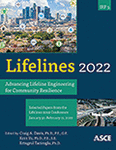2.5D Ground Motion Effects from Excitation of Underground Tunnels by Obliquely Incident Seismic Waves
Publication: Lifelines 2022
ABSTRACT
In densely populated urban areas, the presence of underground tunnels may modify the input motion for the seismic design of the aboveground structures. However, neither building codes nor seismic zonation guidelines have yet considered this matter. In this paper, the effects of an underground tunnel on the ground motion are numerically investigated, in terms of the peak ground acceleration and acceleration response spectrum. Compared with existing related studies, this paper goes further, considering obliquely incident seismic waves. The results indicate that the underground tunnel influences both the magnitude and distribution of the ground accelerations. The amplification of the peak ground accelerations due to the presence of the underground tunnel can be significant, and the amplification factors are functions of the incident angle of seismic waves.
Get full access to this article
View all available purchase options and get full access to this chapter.
REFERENCES
Biot, M. A. (1962). “Generalized theory of acoustic propagation in porous dissipative media.” The Journal of the Acoustical Society of America, 34(9A), 1254–1264.
De Barros, F. C. P., and Luco, J. E. (1993). “Diffraction of obliquely incident waves by a cylindrical cavity embedded in a layered viscoelastic half-space.” Soil Dynamics and Earthquake Engineering, 12(3), 159–171.
Evangelista, L., Landolfi, L., d’Onofrio, A., and Silvestri, F. (2016). “The influence of the 3D morphology and cavity network on the seismic response of Castelnuovo hill to the 2009 Abruzzo earthquake.” Bulletin of Earthquake Engineering, 14(12), 3363–3387.
Gizzi, F. T., and Masini, N. (2006). “Historical damage pattern and differential seismic effects in a town with ground cavities: A case study from Southern Italy.” Engineering Geology, 88(1-2), 41–58.
Lancioni, G., Bernetti, R., Quagliarini, E., and Tonti, L. (2014). “Effects of underground cavities on the frequency spectrum of seismic shear waves.” Advances in Civil Engineering, 2014, 1–17.
Lee, V. W. (1977). “On deformations near circular underground cavity subjected to incident plane SH waves.” Proceedings of the Application of Computer Methods in Engineering Conference, USC, Los Angeles, 951–962.
Liang, J., Ji, X., and Lee, V. W. (2005). “Effects of an underground lined tunnel on ground motion (II): Numerical results.” Rock and Soil Mechanics, 26(4), 520–524. (in Chinese).
Liang, J., Han, B., and Ba, Z. (2013). “3D Diffraction of obliquely incident SH waves by twin infinitely long cylindrical cavities in layered poroelastic half-space.” Earthquake Science, 26(6), 395–406.
MOHURD (Ministry of Housing and Urban-Rural Development). (2010). Code for seismic design of buildings, GB50011-2010. China Architecture & Building Press, Beijing. (in Chinese).
Ortolani, B., Borghini, A., Boschi, S., Del Monte, E., and Vignoli, A. (2012). “Study of vulnerability and damage: the case study of Castelnuovo after L’Aquila earthquake (Italy).” Proceedings of the 15th WCEE-World Conference of Earthquake Engineering, Lisbon, Portugal, 1–10.
Sica, S., Dello Russo, A., Rotili, F., and Simonelli, A. L. (2014). “Ground motion amplification due to shallow cavities in nonlinear soils.” Nat. Hazards, 71(3), 1913–1935.
Stamos, A. A., and Beskos, D. E. (1996). “3-D seismic response analysis of long lined tunnels in half-space.” Soil Dynamics and Earthquake Engineering, 15(2), 111–118.
Yiouta-Mitra, P., Kouretzis, G., Bouckovalas, G., and Sofianos, A. (2007). “Effect of underground structures in earthquake resistant design of surface structures.” In Dynamic Response and Soil Properties, Mandar M. Dewoolkar, and Joseph P. Koester, eds. ASCE, Reston, VA, 1–10.
Zhu, J., Liang, J., and Ba, Z. (2019). “A 2.5 D equivalent linear model for longitudinal seismic analysis of tunnels in water-saturated poroelastic half-space.” Computers and Geotechnics, 109, 166–188.
Zhu, J., Li, X., and Liang, J. (2020). “3D seismic responses of a long lined tunnel in layered poro-viscoelastic half-space by a hybrid FE-BE method.” Engineering Analysis with Boundary Elements, 114, 94–113.
Information & Authors
Information
Published In
History
Published online: Nov 16, 2022
Authors
Metrics & Citations
Metrics
Citations
Download citation
If you have the appropriate software installed, you can download article citation data to the citation manager of your choice. Simply select your manager software from the list below and click Download.
